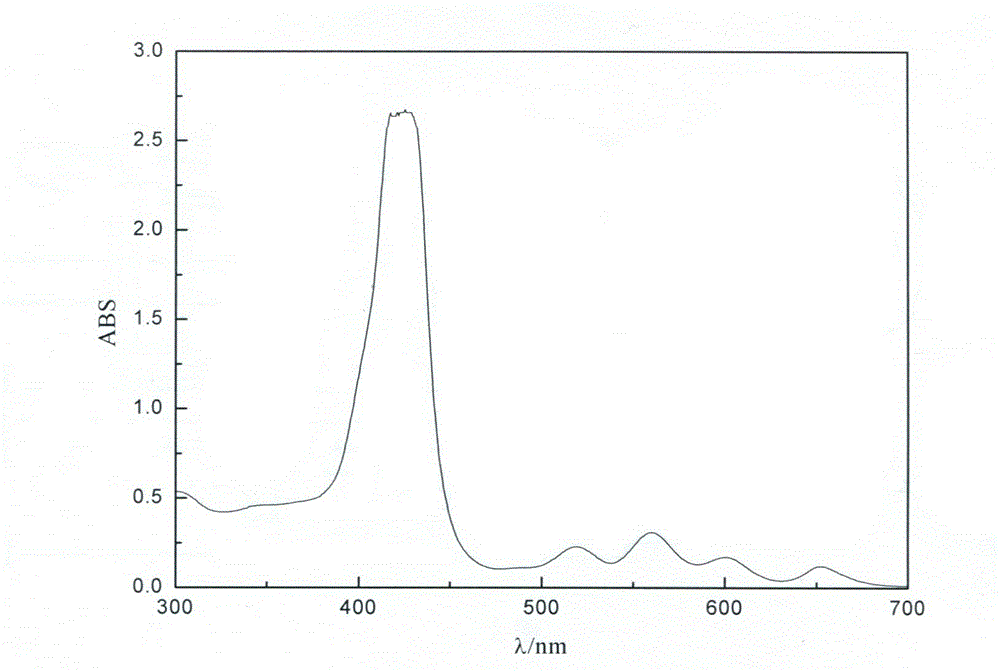Photosensitive fuel for dye-sensitized solar cell and preparation method thereof
A technology of solar cells and photosensitizing dyes, applied in chemical instruments and methods, azo dyes, organic dyes, etc., can solve the problems of high cost and inability to meet large-scale promotion and application, and achieve the effect of improving the absorption rate
- Summary
- Abstract
- Description
- Claims
- Application Information
AI Technical Summary
Problems solved by technology
Method used
Image
Examples
Embodiment 1
[0032] In this embodiment, a method for preparing a novel photosensitive dye for dye-sensitized solar cells comprises the following steps:
[0033] 1) Preparation of 5-(4-aminophenyl)-10,15,20-tris(4-hydroxyphenyl)porphyrin:
[0034] Take 1.5g of 5-(4-nitrophenyl)-10,15,20-tris(4-hydroxyphenyl)porphyrin and 1g of stannous chloride dihydrate in a three-necked flask, and then add 15mL Concentrated hydrochloric acid with a mass fraction of 30% fully dissolves 5-(4-nitrophenyl)-10,15,20-tris(4-hydroxyphenyl)porphyrin and stannous chloride dihydrate, under nitrogen protection , heated up to 65°C and reacted for 5 hours. After the reaction, cooled to room temperature, then adjusted the pH value to 7 with concentrated ammonia water with a mass fraction of 20%, then extracted with dichloromethane, then spin-dried the dichloromethane, and finally used The product was separated by column chromatography on a neutral alumina column to obtain 5-(4-aminophenyl)-10,15,20-tris(4-hydroxypheny...
Embodiment 2
[0055] In this embodiment, a method for preparing a novel photosensitive dye for dye-sensitized solar cells comprises the following steps:
[0056] 1) Preparation of 5-(4-aminophenyl)-10,15,20-tris(4-hydroxyphenyl)porphyrin:
[0057] Take 1.5g of 5-(4-nitrophenyl)-10,15,20-tris(4-hydroxyphenyl)porphyrin and 1.5g of stannous chloride dihydrate in a three-necked flask, and then add 20mL of concentrated hydrochloric acid with a mass fraction of 35% was used to fully dissolve 5-(4-nitrophenyl)-10,15,20-tris(4-hydroxyphenyl)porphyrin and stannous chloride dihydrate. After the reaction, cool to room temperature, adjust the pH value to 8.5 with concentrated ammonia water, then extract with dichloromethane, spin the dichloromethane to dryness, and finally use a neutral alumina column to The product was separated by column chromatography to obtain 5-(4-aminophenyl)-10,15,20-tris(4-hydroxyphenyl)porphyrin;
[0058] 2) Preparation of 5-(4-aminophenyl)-10,15,20-tris(4-hydroxyphenyl)zinc...
Embodiment 3
[0063] In this embodiment, a method for preparing a novel photosensitive dye for dye-sensitized solar cells comprises the following steps:
[0064] 1) Preparation of 5-(4-aminophenyl)-10,15,20-tris(4-hydroxyphenyl)porphyrin:
[0065] Take 2g of 5-(4-nitrophenyl)-10,15,20-tris(4-hydroxyphenyl)porphyrin and 2g of stannous chloride dihydrate in a three-necked flask, and then add 50mL mass Concentrated hydrochloric acid with a fraction of 37% fully dissolves 5-(4-nitrophenyl)-10,15,20-tri(4-hydroxyphenyl)porphyrin and stannous chloride dihydrate, under nitrogen protection, Raise the temperature to 75°C and react for 1 hour. After the reaction, cool to room temperature, then adjust the pH value to 10 with concentrated ammonia water, then extract with dichloromethane, spin the dichloromethane to dryness, and finally test the product with a neutral alumina column. 5-(4-aminophenyl)-10,15,20-tris(4-hydroxyphenyl)porphyrin was obtained by column chromatography separation;
[0066] 2)...
PUM
| Property | Measurement | Unit |
|---|---|---|
| melting point | aaaaa | aaaaa |
| melting point | aaaaa | aaaaa |
| melting point | aaaaa | aaaaa |
Abstract
Description
Claims
Application Information
 Login to View More
Login to View More - R&D
- Intellectual Property
- Life Sciences
- Materials
- Tech Scout
- Unparalleled Data Quality
- Higher Quality Content
- 60% Fewer Hallucinations
Browse by: Latest US Patents, China's latest patents, Technical Efficacy Thesaurus, Application Domain, Technology Topic, Popular Technical Reports.
© 2025 PatSnap. All rights reserved.Legal|Privacy policy|Modern Slavery Act Transparency Statement|Sitemap|About US| Contact US: help@patsnap.com



